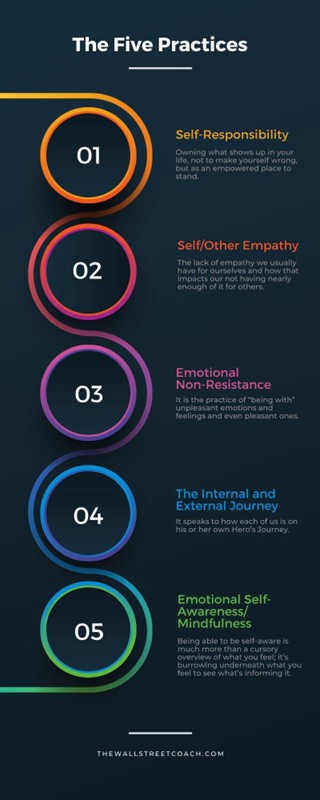The idea of having a more conscious life and/or conscious businesses is nothing new, states Kim Ann Curtin of The Wall Street Coach.
At this point, John Mackey’s book. Conscious Capitalism. has been out for years. Consciousness is in ads for clothing companies and is part of the branding of many other companies. It’s even a big part of investing and big business, as evidenced by my book, Transforming Wall Street: A Conscious Path for a New Future.
But you might be amazed by the impact that greater consciousness can have on your trading or investing.
That leads to some important questions….How can improved consciousness affect traders and investors? Is it really possible to become more conscious?
Here, I’ll review some simple, and practical steps to help traders and investors become more conscious and awake. However, these practices aren’t a quick fix—the more you practice them the more they will weave their way through you and inform how you approach everything personally and professionally.
An important note: consciousness is about being honest with yourself—which can be scary. This process does take courage! But remember that you have more strength than you give yourself credit for. And what’s waiting on the other end, is a reward that will make it all worthwhile.
Here Are the Steps:
1. Own your actions.
Self-responsibility is about taking ownership of your actions and responses to whatever circumstances you are confronted with. The first time I really learned about self-responsibility was in 2005 at The Landmark Forum, a personal development course. It opened my eyes to the endless possibilities of living a conscious life where I was able to stop feeling like a victim of life and step into the possibility that was all around me. Two excellent books on the subject are The Art of Possibility by Ben Zander and The Three Laws of Performance by Zaffron and Logan. Taking responsibility is the first step in developing your awareness.
2. Stop blaming yourself!
People often get confused between self-responsibility and self-criticism. Self-responsibility is about owning your responses to life’s situations. Self-criticism is about blaming ourselves for responding in a certain way. Avoiding self-criticism and self-blame is the foundation underneath building a consciously lived life. Learning to differentiate between the two is a crucial step in the process.
3. Be with your emotions.
Releasing or feeling your emotions is one of the most effective ways to become more awake. The first step is to learn how to be with your emotions in an unbiased, non-judgmental way. Emotions won’t always be pleasant or enjoyable—often very unpleasant ones will surface, like pain, sadness, guilt, and discomfort. The key is to not panic when they arise. They are like weather patterns. They come and they go. They will never stay put forever. Try to avoid labeling them. Just acknowledge that they are there. Once we acknowledge them, our bodies and minds can go through the necessary process to release them and lead us to emotional freedom (see the next step). Raphael Cushnir talks more about this in his book, The One Thing Holding You Back, which I highly recommend to help you access and release these feelings.
4. Practice present-moment awareness.
“Anxiety, the illness of our time, comes primarily from our inability to dwell in the present moment.”—Thich Nhat Hanh.
So how does one go through the process of releasing emotions? The practice that I suggest is one in which a person recognizes that they are feeling something and notices where or how the feeling manifests itself. Feelings are experienced in the body. Connecting to the physical sensation in your chest, head, stomach, etc will help you become more aware of how they ebb and flow. The more you practice being in the present moment with these feelings, the more you’ll notice that they will begin to move through your body and physically wash over you and out of you. Releasing themselves if indeed we don’t resist them.
5. Practice self-empathy.
When practicing the release of these emotions, make sure to be patient with yourself. Being in the present moment and being a feeler of your feelings is not something you have ever been encouraged to do. Most of the advice you’ve received is to “Get over it!” or “Deal with it!” or some sort of John Wayne mentality of advice. And now with our fast-paced environment all around us 24/7, it seems to advocate and support only forward movement. What this does is rob us of the here and now. This type of practice will take time. Understand that it is a process—one which will be very rewarding if you slow down to experience it!
6. Practice empathy for others.
As important as self-empathy is, empathy for others is equally as crucial. In the midst of any challenging situation, it’s very easy to blame, judge, or disconnect from others. And this can only be done after you’ve done it for yourself, but the key is remembering that everyone is just trying to get their needs met. Sometimes people do that in a way that is costly to themselves and others but remembering that that is what’s at hand and will assist you in empathizing with them. Identify what their need is if you are able to. Try to listen past what they are thinking and discover what they might be feeling. Empathy is about being present to ourselves and others. In other words, tuning into “What is alive in them/us, now?” “Speak Peace in a World of Conflict” by Marshall Rosenberg expands on this idea of empathy.
7. The journey to consciousness.
“If every day is an awakening, you will never grow old. You will just keep growing.” —Gail Sheehy
Becoming more awake is a journey. It usually doesn’t happen overnight. It is often a journey that begins with an external stimulus like losing a job, giving birth, a health challenge, or an ending of a marriage. Joseph Campbell calls this journey the “Hero’s Journey” and discusses this more in his book, The Hero with a Thousand Faces. Additionally, I highly recommend you watch or rent Finding Joe the Movie online, featuring Entheos founder Brian Johnson.
8. The internal journey.
“We must be willing to let go of the life we planned so as to have the life that is waiting for us.”—Joseph Campbell
Not only is becoming more awake an external journey, but it is also an internal journey. That means letting go of things—most of all letting go of the image we have of ourselves. To understand more about the internal/external journeys that we face, have a look at The Power of Myth, a collection of interviews that Bill Moyers did with Joseph Campbell for PBS.
9. Practice self-awareness.
Self-awareness is what begins to happen naturally in the steps of achieving consciousness. It is essentially the ability to observe once feelings and behaviors in a way that is unbiased, neutral, and curious. Curiosity means noticing the changes in your life, or even your body as you age. Your mind feels more tamed and you experience the “monkey mind” less and less. Feelings and thoughts that rise to the top begin to flow away effortlessly. Encouraging this curiosity of “noticing with neutrality” helps you be with all of your feelings and emotions instead of being at their mercy. For amazing insight into self-awareness, read Falling into Grace by Adyashanti.
10. Practice mindfulness.
“The biggest barrier to awakening is the belief that it is something rare.” —Adyashanti
Mindful breathing and meditation can have dramatic effects on your wellness both mentally and physically. And it’s just one step from there that you can begin to practice mindful breathing even when not meditating! Meditation is one of the most effective ways to teach your mind and body to be present. Once you begin to get used to even just the idea of stillness and accept the kaleidoscope of emotions that may come and go, your behavior begins to change. Your thoughts become more focused and you find yourself less attached to outcomes and beliefs.
Moreover, achieving more consciousness and becoming more self-aware is a combination of what I call The Five Practices. They are the above ten steps synthesized down to five.
While interviewing top investors like Bill Ackman, Jim Rogers, John Bogle, and other Wall Street Legends for my book, Transforming Wall Street, I discovered they share a set of five characteristics that helped create their success:

The Five Practices
1) Self-responsibility
2) Self/other empathy
3) Emotional Non-resistance/Present moment awareness
4) Internal/External Journey
5) Self Awareness/Mindfulness.
Ready to start each day with precision? If you’d like to learn about how you can implement these Five Practices in your life, join the thousands that receive my weekly emails on redesigning high performance.





















